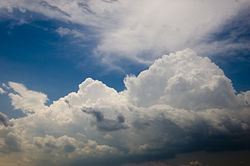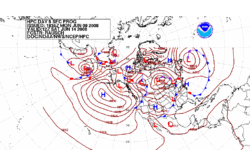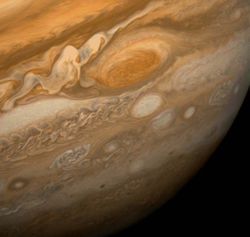Weather
2008/9 Schools Wikipedia Selection. Related subjects: Climate and the Weather
The weather is a set of all the phenomena in a given atmosphere at a given time. Weather phenomena lie in the hydrosphere and troposphere. Weather refers to current activity, as opposed to the term climate, which refers to the average atmospheric conditions over longer periods of time. When used without qualification, "weather" is understood to be the weather of Earth.
Weather occurs due to density (temperature and moisture) differences between one place to another. These differences can occur due to the sun angle at any particular spot, which varies by latitude from the tropics. The strong temperature contrast between polar and tropical air gives rise to the jet stream. Weather systems in the mid-latitudes, such as extratropical cyclones, are caused by instabilities of the jet stream flow. Because the Earth's axis is tilted relative to its orbital plane, sunlight is incident at different angles at different times of the year. On Earth's surface, temperatures usually range between ±40 °C (±72 °F). Over thousands to hundreds of thousands of years, changes in Earth's orbit affect the amount and distribution of solar energy received by the Earth and influence long-term climate.
Surface temperature differences in turn cause pressure differences. Higher altitudes are cooler than lower altitudes due to differences in compressional heating. Weather forecasting is the application of science and technology to predict the state of the atmosphere for a future time and a given location. The atmosphere is a chaotic system, so small changes to one part of the system can grow to have large effects on the system as a whole. Human attempts to control the weather have occurred throughout human history, and there is evidence that human activity such as agriculture and industry has inadvertently modified weather patterns.
Studying how the weather works on other planets has been helpful in understanding how weather works on Earth. A famous landmark in the Solar System, Jupiter's Great Red Spot, is an anticyclonic storm known to have existed for at least 300 years. However, weather is not limited to planetary bodies. A star's corona is constantly being lost to space, creating what is essentially a very thin atmosphere throughout the Solar System. The movement of mass ejected from the Sun is known as the solar wind.
Cause
On Earth, common weather phenomena include wind, cloud, rain, snow, fog and dust storms. Less common events include natural disasters such as tornadoes, hurricanes and ice storms. Almost all familiar weather phenomena occur in the troposphere (the lower part of the atmosphere). Weather does occur in the stratosphere and can affect weather lower down in the troposphere, but the exact mechanisms are poorly understood.
Weather occurs primarily due to density (temperature and moisture) differences between one place to another. These differences can occur due to the sun angle at any particular spot, which varies by latitude from the tropics. In other words, the farther from the tropics you lie, the lower the sun angle is, which causes those locations to be cooler due to the indirect sunlight. The strong temperature contrast between polar and tropical air gives rise to the jet stream. Weather systems in the mid-latitudes, such as extratropical cyclones, are caused by instabilities of the jet stream flow (see baroclinity). Weather systems in the tropics, such as monsoons or organized thunderstorm systems, are caused by different processes.
Because the Earth's axis is tilted relative to its orbital plane, sunlight is incident at different angles at different times of the year. In June the Northern Hemisphere is tilted towards the sun, so at any given Northern Hemisphere latitude sunlight falls more directly on that spot than in December (see Effect of sun angle on climate). This effect causes seasons. Over thousands to hundreds of thousands of years, changes in Earth's orbital parameters affect the amount and distribution of solar energy received by the Earth and influence long-term climate (see Milankovitch cycles).
Uneven solar heating (the formation of zones of temperature and moisture gradients, or frontogenesis) can also be due to the weather itself in the form of cloudiness and precipitation. Higher altitudes are cooler than lower altitudes, which is explained by the lapse rate. On local scales, temperature differences can occur because different surfaces (such as oceans, forests, ice sheets, or man-made objects) have differing physical characteristics such as reflectivity, roughness, or moisture content.
Surface temperature differences in turn cause pressure differences. A hot surface heats the air above it and the air expands, lowering the air pressure and its density. The resulting horizontal pressure gradient accelerates the air from high to low pressure, creating wind, and Earth's rotation then causes curvature of the flow via the Coriolis effect. The simple systems thus formed can then display emergent behaviour to produce more complex systems and thus other weather phenomena. Large scale examples include the Hadley cell while a smaller scale example would be coastal breezes.
The atmosphere is a chaotic system, so small changes to one part of the system can grow to have large effects on the system as a whole. This makes it difficult to accurately predict weather more than a few days in advance, though weather forecasters are continually working to extend this limit through the scientific study of weather, meteorology. It is theoretically impossible to make useful day-to-day predictions more than about two weeks ahead, imposing an upper limit to potential for improved prediction skill. Chaos theory says that the slightest variation in the motion of the ground can grow with time. This idea is sometimes called the butterfly effect, from the idea that the motions caused by the flapping wings of a butterfly eventually could produce marked changes in the state of the atmosphere. Because of this sensitivity to small changes it will never be possible to make perfect forecasts, although there still is much potential for improvement.
The sun and oceans can also affect the weather of land. If the sun heats up ocean waters for a period of time, water can evaporate. Once evaporated into the air, the moisture can spread throughout nearby land, thus making it cooler.
Shaping the planet Earth
Weather is one of the fundamental processes that shape the Earth. The process of weathering breaks down rocks and soils into smaller fragments and then into their constituent substances. These are then free to take part in chemical reactions that can affect the surface further (such as acid rain) or are reformed into other rocks and soils. In this way, weather plays a major role in erosion of the surface.
Effect on humans
Weather has played a large and sometimes direct part in human history. Aside from climatic changes that have caused the gradual drift of populations (for example the desertification of the Middle East, and the formation of land bridges during glacial periods), extreme weather events have caused smaller scale population movements and intruded directly in historical events. One such event is the saving of Japan from invasion by the Mongol fleet of Kublai Khan by the Kamikaze winds in 1281. French claims to Florida came to an end in 1565 when a hurricane destroyed the French fleet, allowing Spain to conquer Fort Caroline. More recently, Hurricane Katrina redistributed over one million people from the central Gulf coast elsewhere across the United States, becoming the largest diaspora in the history of the United States.
Though weather affects people in drastic ways, it can also affect the human race in simpler ways. The human body is negatively affected by extremes in temperature, humidity, and wind. Mood is also affected by the weather.
Forecasting
Weather forecasting is the application of science and technology to predict the state of the atmosphere for a future time and a given location. Human beings have attempted to predict the weather informally for millennia, and formally since at least the nineteenth century. Weather forecasts are made by collecting quantitative data about the current state of the atmosphere and using scientific understanding of atmospheric processes to project how the atmosphere will evolve.
Once an all human endeavor based mainly upon changes in barometric pressure, current weather conditions, and sky condition, forecast models are now used to determine future conditions. Human input is still required to pick the best possible forecast model to base the forecast upon, which involves pattern recognition skills, teleconnections, knowledge of model performance, and knowledge of model biases. The chaotic nature of the atmosphere, the massive computational power required to solve the equations that describe the atmosphere, error involved in measuring the initial conditions, and an incomplete understanding of atmospheric processes mean that forecasts become less accurate as the difference in current time and the time for which the forecast is being made (the range of the forecast) increases. The use of ensembles and model consensus help narrow the error and pick the most likely outcome.
There are a variety of end users to weather forecasts. Weather warnings are important forecasts because they are used to protect life and property. Forecasts based on temperature and precipitation are important to agriculture, and therefore to commodity traders within stock markets. Temperature forecasts are used by utility companies to estimate demand over coming days. On an everyday basis, people use weather forecasts to determine what to wear on a given day. Since outdoor activities are severely curtailed by heavy rain, snow and the wind chill, forecasts can be used to plan activities around these events, and to plan ahead and survive them.
Modification
The wish to control the weather is evident throughout human history: from ancient rituals intended to bring rain for crops to the U.S. Military Operation Popeye, an attempt to disrupt supply lines by lengthening the North Vietnamese monsoon. The most successful attempts at influencing weather involve cloud seeding; they include the fog- and low stratus dispersion techniques employed by major airports, techniques used to increase winter precipitation over mountains, and techniques to suppress hail.
Whereas there is inconclusive evidence for these techniques' efficacy, there is extensive evidence that human activity such as agriculture and industry results in inadvertent weather modification:
- Acid rain, caused by industrial emission of sulfur dioxide and nitrogen oxides into the atmosphere, adversely effects freshwater lakes, vegetation, and structures.
- Anthropogenic pollutants reduce air quality and visibility.
- Climate change caused by human activities that emit greenhouse gases into the air is expected to affect the frequency of extreme weather events such as drought, extreme temperatures, flooding, high winds, and severe storms.
The effects of inadvertent weather modification may pose serious threats to many aspects of civilization, including ecosystems, natural resources, food and fibre production, economic development, and human health..
Extremes on Earth
On Earth, temperatures usually range between ±40 °C (±72 °F). The range of climates and latitudes across the planet can offer extremes of temperature outside this range. The coldest air temperature ever recorded on Earth is −89.2 °C (−129 °F), at Vostok Station, Antarctica on 21 July 1983. The hottest air temperature ever recorded was 57.7 °C (135.9 °F) at Al 'Aziziyah, Libya, on 13 September 1922. The highest recorded average annual temperature was 34.4 °C (93.9 °F) at Dallol, Ethiopia. The coldest recorded average annual temperature was −55.1 °C (−67 °F) at Vostok Station, Antarctica. The coldest average annual temperature in a permanently inhabited location is at Eureka, Nunavut, in Canada, where the annual average temperature is −19.7 °C (−3 °F).
Extraterrestrial with the Solar System
Studying how the weather works on other planets has been seen as helpful in understanding how it works on Earth. Weather on other planets follows many of the same physical principles as weather on Earth, but occurs on different scales and in atmospheres having different chemical composition. The Cassini–Huygens mission to Titan discovered clouds formed from methane or ethane which deposit rain composed of liquid methane and other organic compounds. Earth's atmosphere includes six latitudinal circulation zones, three in each hemisphere. In contrast, Jupiter's banded appearance shows many such zones, Titan has a single jet stream near the 50th parallel north latitude, and Venus has a single jet near the equator.
One of the most famous landmarks in the Solar System, Jupiter's Great Red Spot, is an anticyclonic storm known to have existed for at least 300 years. On other gas giants, the lack of a surface allows the wind to reach enormous speeds: gusts of up to 600&nsbp;metres per second (about 2,100 kilometres per hour (1,300 mph)) have been measured on the planet Neptune. This has created a puzzle for planetary scientists. The weather is ultimately created by solar energy and the amount of energy received by Neptune is only about 1/900th of that received by Earth, yet the intensity of weather phenomena on Neptune is far greater than on Earth. The strongest planetary winds discovered so far are on the extrasolar planet HD 189733 b, which is thought to have easterly winds moving at more than 9,600 kilometres per hour (6,000 mph).
Space weather
Weather is not limited to planetary bodies. A star's corona is constantly being lost to space, creating what is essentially a very thin atmosphere throughout the Solar System. The movement of mass ejected from the Sun is known as the solar wind. Inconsistencies in this wind and larger events on the surface of the star, such as coronal mass ejections, form a system that has features analogous to conventional weather systems (such as pressure and wind) and is generally known as space weather. Coronal mass ejections have been tracked as far out in the solar system as Saturn. The activity of this system can affect planetary atmospheres and occasionally surfaces. The interaction of the solar wind with the terrestrial atmosphere can produce spectacular aurorae, and can play havoc with electrically sensitive systems such as electricity grids and radio signals.







